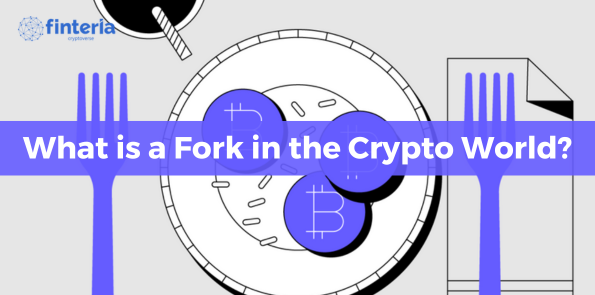What is a Fork in the Crypto World?

Ricerca di mercato
The world of cryptocurrencies has introduced various concepts and terminologies that might seem unfamiliar to those new to the field. One such term is "fork." In the crypto world, a fork refers to a fundamental change in the underlying protocol of a blockchain network. It is a significant event that can lead to the creation of new cryptocurrencies and, at times, even impact the existing ones. To understand forks better, let's delve into the different types of forks and their implications.
Types of Forks:
1. Hard Fork:
A hard fork is a type of fork that occurs when there is a substantial and irreversible change to a blockchain's protocol. This change is typically implemented to introduce new features, improve functionality, or address critical issues within the network. When a hard fork takes place, the existing blockchain splits into two separate chains, each following its own set of rules and protocols.
One of the defining characteristics of a hard fork is its backward incompatibility with previous versions of the blockchain. This means that nodes operating on the old protocol will not recognize or accept the blocks mined on the new chain, and vice versa. As a result, a hard fork can lead to a permanent divergence in the blockchain's history and the creation of two distinct cryptocurrencies.
Hard forks often arise from disagreements within the blockchain community regarding fundamental aspects of the network, such as consensus mechanisms, block size limits, or governance models. When consensus cannot be reached on proposed changes, a group of developers and participants may decide to initiate a hard fork to implement their preferred modifications. By creating a new chain, they can pursue their vision and demonstrate an alternative path for the blockchain's evolution.
One of the most well-known hard forks in the crypto world is the creation of Bitcoin Cash (BCH) from Bitcoin (BTC) in August 2017. The hard fork was driven by a disagreement over the block size limit. Bitcoin Cash aimed to increase the block size to enable more transactions per block and improve scalability. As a result, holders of Bitcoin at the time of the fork received an equivalent amount of Bitcoin Cash, allowing them to hold both cryptocurrencies separately.
2. Soft Fork:
In contrast to hard forks, soft forks are backward-compatible upgrades to a blockchain's protocol. They introduce changes that are within the rules and parameters of the existing blockchain, ensuring that nodes operating on the old protocol can still recognize and validate the new blocks.
Soft forks typically involve tightening or restricting the rules of the blockchain. For example, changing the transaction format, modifying the consensus mechanism, or introducing additional security measures. Nodes that have upgraded to the new protocol can still interact with non-upgraded nodes, as the changes are designed to be compatible with the existing blockchain.
One notable example of a soft fork is the implementation of Segregated Witness (SegWit) in the Bitcoin network. SegWit aimed to address the issue of transaction malleability and increase the transaction capacity of the Bitcoin blockchain. By changing the transaction format and segregating signature data, SegWit reduced the space occupied by transactions within a block. This upgrade was backward-compatible, allowing upgraded nodes to validate transactions from non-upgraded nodes, although non-upgraded nodes were not able to take advantage of the new features.
Soft forks are generally seen as less contentious than hard forks since they do not lead to a permanent split in the blockchain. They require a majority of miners or nodes to adopt the new protocol for it to be effective. However, there can still be disagreements within the community regarding the implementation and necessity of soft forks, which may result in a portion of the network choosing not to upgrade.
Implications of Forks:
1. Creation of New Cryptocurrencies:
Hard forks often result in the creation of new cryptocurrencies. Holders of the original cryptocurrency at the time of the fork receive an equal amount of the newly created cryptocurrency. This allows them to maintain ownership of both assets separately. Depending on the community's acceptance and market demand, the new cryptocurrency may gain its own value and establish its presence in the market.
2. Community and Development Divergence:
Forks can arise due to differences in opinions, ideologies, or technical decisions within the blockchain community. Disagreements regarding important aspects such as scalability, governance, or consensus mechanisms can lead to a hard fork. This division can result in two separate communities with different visions, leading to variations in development and future updates.
3. Network Security and Consensus:
Forks can impact the security and consensus mechanisms of a blockchain network. After a hard fork, the computing power of the network is divided between the original chain and the newly created one. This could potentially weaken the security of both chains, as the overall hashing power is reduced. Additionally, forks can introduce changes to the consensus algorithm, which may impact the network's decentralization and trust model.
4. Market Volatility:
The announcement or occurrence of a fork can often cause significant market volatility for the associated cryptocurrencies. Traders and investors closely monitor forks as they can lead to price fluctuations and opportunities for profit. The uncertainty surrounding the future of the forked cryptocurrencies can lead to rapid price movements and increased trading volumes.
Conclusion:
Forks are an essential aspect of the crypto world, representing significant events that can shape the landscape of cryptocurrencies and blockchain networks. Whether they result in the creation of new cryptocurrencies, community divisions, or alterations in network security, forks have a substantial impact on the ecosystem. Understanding the different types of forks and their implications can provide insights into the dynamics of the crypto space, enabling individuals to make more informed decisions and navigate the ever-evolving world of cryptocurrencies.



